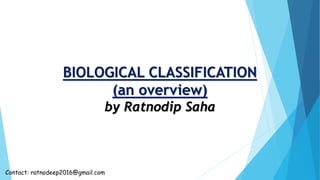Biological classification of organisms by Ratnodip Saha
•Download as PPTX, PDF•
3 likes•251 views
An overview of biological classification including two kingdom classification (by Carolus Linnaeus), two kingdom classification (by Aristotle) and five kingdom classification (by R. H. Whittaker) and short discussion on five kingdoms.
Report
Share
Report
Share

More Related Content
What's hot
What's hot (20)
The Living World Biology Class notes for NEET preparation

The Living World Biology Class notes for NEET preparation
Similar to Biological classification of organisms by Ratnodip Saha
Similar to Biological classification of organisms by Ratnodip Saha (20)
Classification of microorganisms-MICROBIOLOGY QUICK LEARN

Classification of microorganisms-MICROBIOLOGY QUICK LEARN
Historical resume of systematics by VISHAL BHOJYAWAL

Historical resume of systematics by VISHAL BHOJYAWAL
Recently uploaded
Recently uploaded (20)
Forest laws, Indian forest laws, why they are important

Forest laws, Indian forest laws, why they are important
Engler and Prantl system of classification in plant taxonomy

Engler and Prantl system of classification in plant taxonomy
Call Girls in Mayapuri Delhi 💯Call Us 🔝9953322196🔝 💯Escort.

Call Girls in Mayapuri Delhi 💯Call Us 🔝9953322196🔝 💯Escort.
Recombinant DNA technology( Transgenic plant and animal)

Recombinant DNA technology( Transgenic plant and animal)
Vision and reflection on Mining Software Repositories research in 2024

Vision and reflection on Mining Software Repositories research in 2024
Environmental Biotechnology Topic:- Microbial Biosensor

Environmental Biotechnology Topic:- Microbial Biosensor
Neurodevelopmental disorders according to the dsm 5 tr

Neurodevelopmental disorders according to the dsm 5 tr
Twin's paradox experiment is a meassurement of the extra dimensions.pptx

Twin's paradox experiment is a meassurement of the extra dimensions.pptx
The dark energy paradox leads to a new structure of spacetime.pptx

The dark energy paradox leads to a new structure of spacetime.pptx
Pests of soyabean_Binomics_IdentificationDr.UPR.pdf

Pests of soyabean_Binomics_IdentificationDr.UPR.pdf
Pests of jatropha_Bionomics_identification_Dr.UPR.pdf

Pests of jatropha_Bionomics_identification_Dr.UPR.pdf
Artificial Intelligence In Microbiology by Dr. Prince C P

Artificial Intelligence In Microbiology by Dr. Prince C P
Analytical Profile of Coleus Forskohlii | Forskolin .pdf

Analytical Profile of Coleus Forskohlii | Forskolin .pdf
Biological classification of organisms by Ratnodip Saha
- 1. BIOLOGICAL CLASSIFICATION (an overview) by Ratnodip Saha Contact: ratnodeep2016@gmail.com
- 2. Topics: What is biological classification Evolution of biological classification Five kingdom classification Monera Protista Fungi Plantae Animalia
- 3. What is Biological classification? It is a scientific procedure, by which we classify organisms to different groups on the basis of similarities of various characters among them.
- 4. Organisms plants herbs Shrubs trees animals Anaima (RBC absent) Enaima (RBC present) Aristotle Using simple morphological characters, Aristotle classified organisms among animals & plants. Plants were classified into herbs, shrubs & trees. Animals were classified into anaima & eneima, on the basis of absence & presence of RBC.
- 5. Organisms Animalia Plantae Linnaeus Linnaeus classified organisms into animalia & plantae. Classification criteria- cell wall locomotion mode of nutrition response to external stimuli contractile system
- 6. Organisms Monera Protista Fungi Plantae Animalia R. H. Whittaker At 1996, R. H. Whittaker proposed the five kingdom classification of organisms- monera, Protista, fungi, plantae & animalia. Classification criteria- cell structure thallus organization mode of nutrition reproduction phylogenetic relation
- 7. Monera: a) Unicellular organisms with a prokaryotic cell organization. b) Nuclear membrane absent. c) Autotrophic or heterotrophic. bacteria
- 8. Protista: a) Unicellular organisms with a eukaryotic cell organization. b) Nucleus & other membrane bound organelles present. c) Autotrophic or heterotrophic amoeba
- 9. Fungi: a) Multicellular organisms with eukaryotic cell organisations. b) Mainly heterotrophic. fungi
- 10. Plantae: a) Multicellular organism with eukaryotic cell organization. b) Chlorophyll containing. c) Mainly autotrophic. d) Few members of plantae are partially insectivorous & parasite.
- 11. Animalia: a) Multicellular organisms with eukaryotic cell organization. b) Lack cell wall. c) Directly or indirectly dependent on plants for food. That’s why heterotrophic. d) Digest their food, the mode of nutrition is holozoic.
